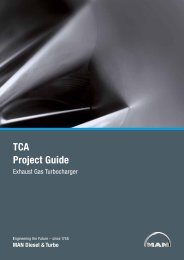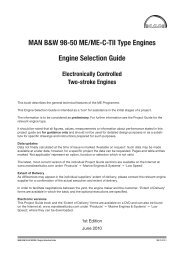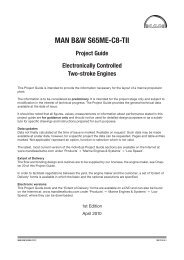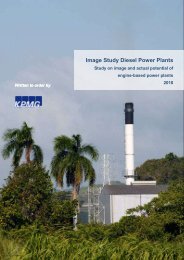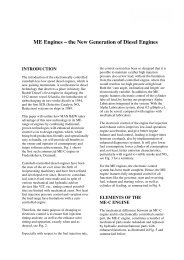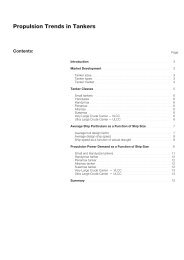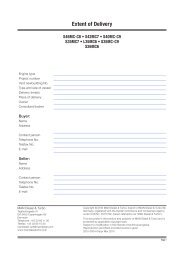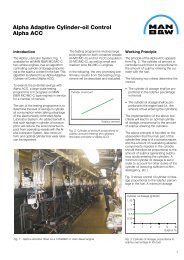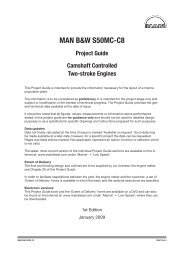This section is available on request - MAN Diesel & Turbo
This section is available on request - MAN Diesel & Turbo
This section is available on request - MAN Diesel & Turbo
Create successful ePaper yourself
Turn your PDF publications into a flip-book with our unique Google optimized e-Paper software.
<strong>MAN</strong> B&W 5.17<br />
Shaftline Earthing Device<br />
Scope and field of applicati<strong>on</strong><br />
A difference in the electrical potential between the<br />
hull and the propeller shaft will be generated due<br />
to the difference in materials and to the propeller<br />
being immersed in sea water.<br />
In some cases, the difference in the electrical<br />
potential has caused spark erosi<strong>on</strong> <strong>on</strong> the thrust,<br />
main bearings and journals of the crankshaft of<br />
the engine.<br />
In order to reduce the electrical potential between<br />
the crankshaft and the hull and thus prevent spark<br />
erosi<strong>on</strong>, a highly efficient shaftline earthing device<br />
must be installed.<br />
The shaftline earthing device should be able to<br />
keep the electrical potential difference below 50<br />
mV DC, and a shaft-to-hull m<strong>on</strong>itoring equipment<br />
with an mV-meter and with an output signal to the<br />
alarm system must be installed so that the potential<br />
and thus the correct functi<strong>on</strong> of the shaftline<br />
earthing device can be m<strong>on</strong>itored.<br />
Note that <strong>on</strong>ly <strong>on</strong>e shaftline earthing device <str<strong>on</strong>g>is</str<strong>on</strong>g><br />
needed in the propeller shaft system.<br />
Fig. 5.17.01<br />
������������<br />
�����������<br />
���������<br />
<strong>MAN</strong> B&W MC/MC�C, ME-B/ME/ME�C engines<br />
���������<br />
��������������<br />
���������<br />
<strong>MAN</strong> <strong>Diesel</strong><br />
Design descripti<strong>on</strong> of the shaftline<br />
earthing device<br />
Page 1 of 3<br />
The shaftline earthing device c<strong>on</strong>s<str<strong>on</strong>g>is</str<strong>on</strong>g>ts of two silver<br />
slip rings, two arrangements for holding brushes<br />
including c<strong>on</strong>necting cables and m<strong>on</strong>itoring<br />
equipment with an mV-meter and an output signal<br />
for alarm.<br />
The slip rings should be made of solid silver or<br />
back-up rings of cobber with a silver layer all over.<br />
The expected life span of the silver layer <strong>on</strong> the<br />
slip rings should be minimum 5 years.<br />
The brushes should be made of minimum 80%<br />
silver and 20% graphite to ensure a sufficiently<br />
electrical c<strong>on</strong>ducting capability.<br />
Res<str<strong>on</strong>g>is</str<strong>on</strong>g>tivity of the silver should be less than 0.1μ<br />
Ohm x m. The total res<str<strong>on</strong>g>is</str<strong>on</strong>g>tance from the shaft to<br />
the hull must not exceed 0.005 Ohm. For a wellfuncti<strong>on</strong>ing<br />
shaftline earthing device, the res<str<strong>on</strong>g>is</str<strong>on</strong>g>tance<br />
<str<strong>on</strong>g>is</str<strong>on</strong>g> expected to be approximately 0.001 Ohm.<br />
�����<br />
���������<br />
�����������<br />
����������<br />
���������<br />
�������������<br />
������������<br />
�����������<br />
�����<br />
���������<br />
�����������<br />
�����<br />
��������<br />
������<br />
079 21 82-1.2.1.0<br />
198 49 29�2.3



